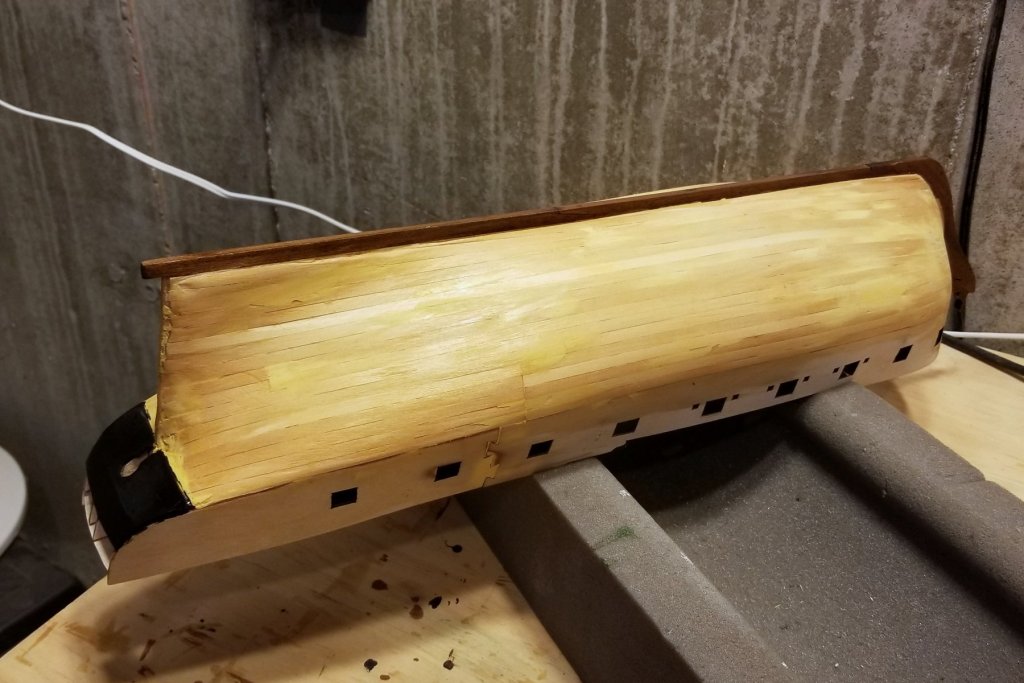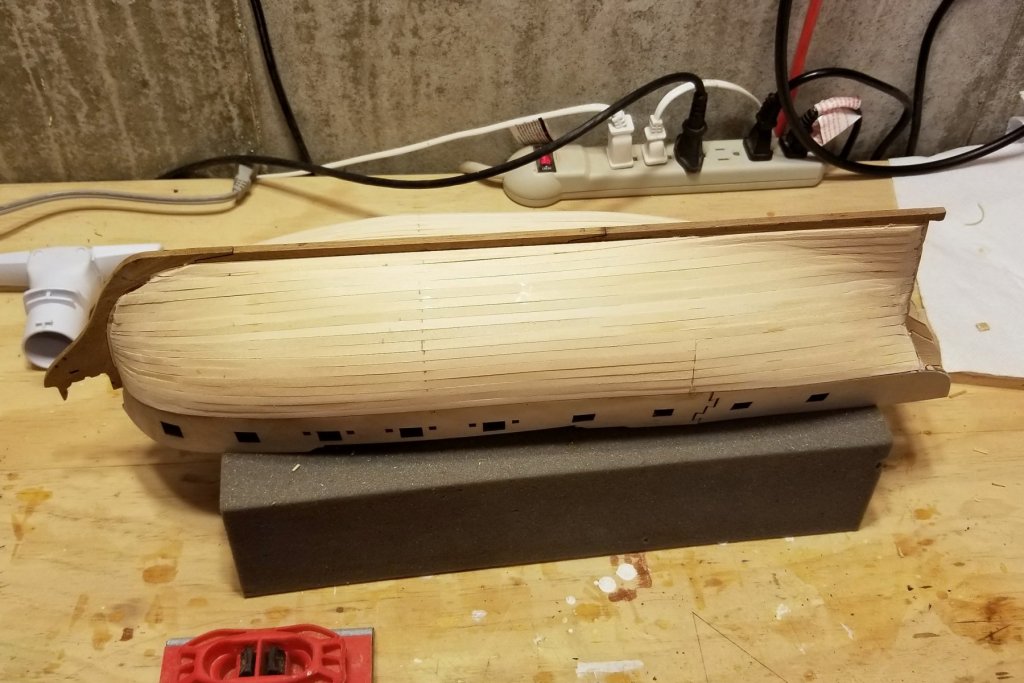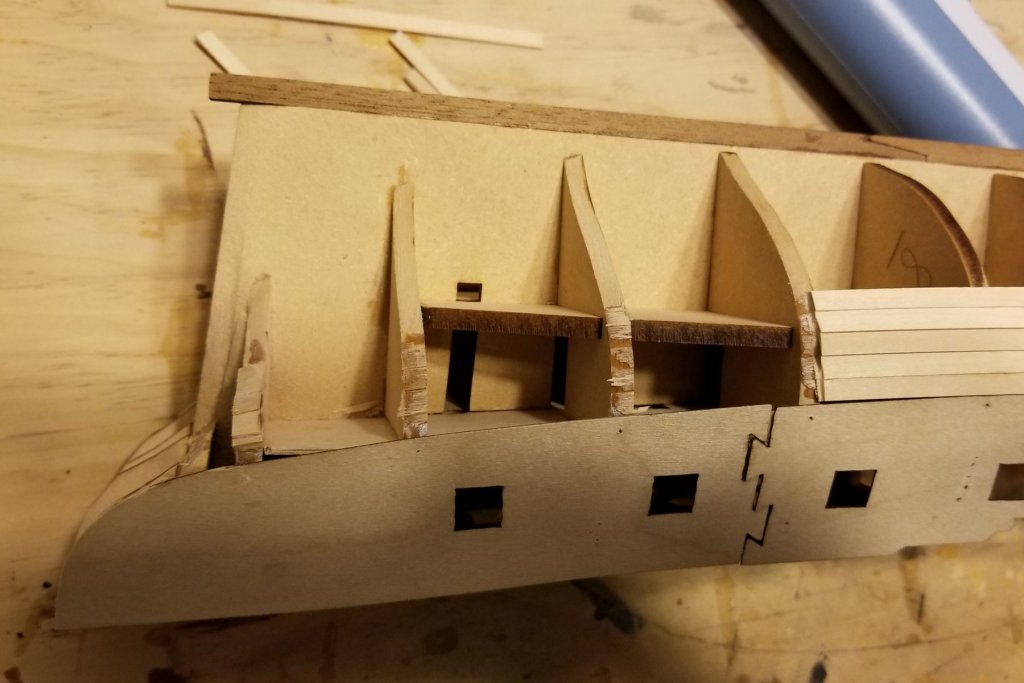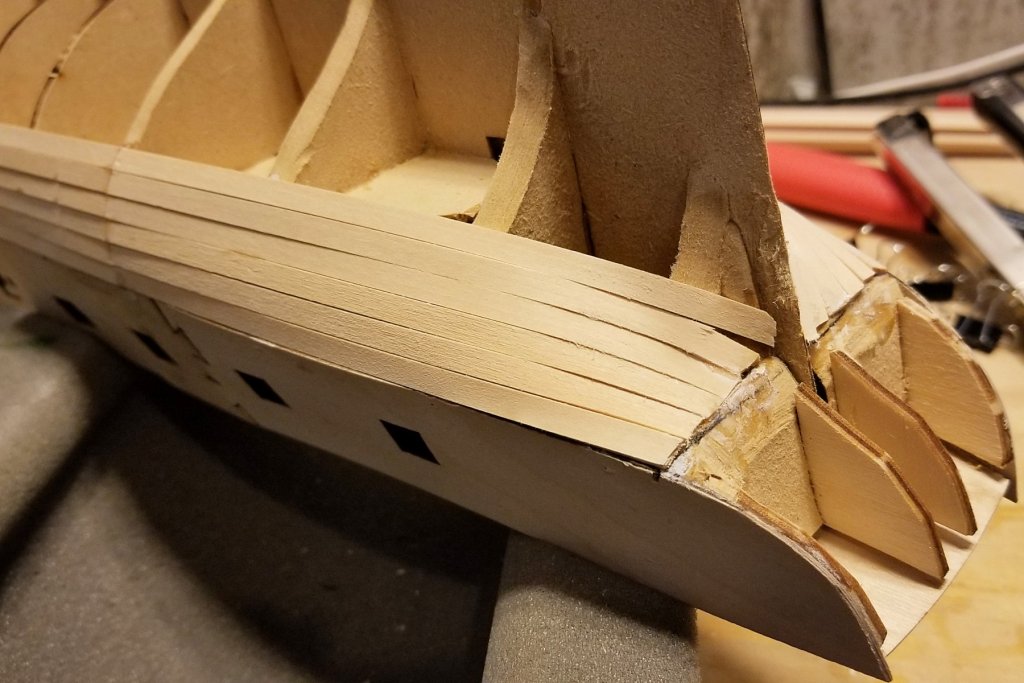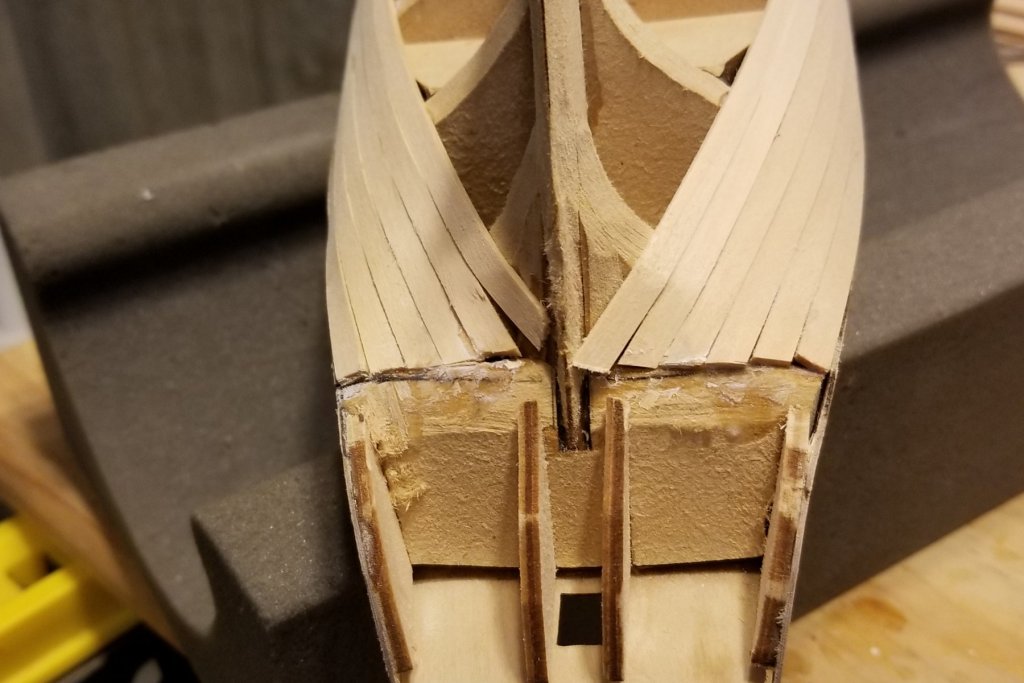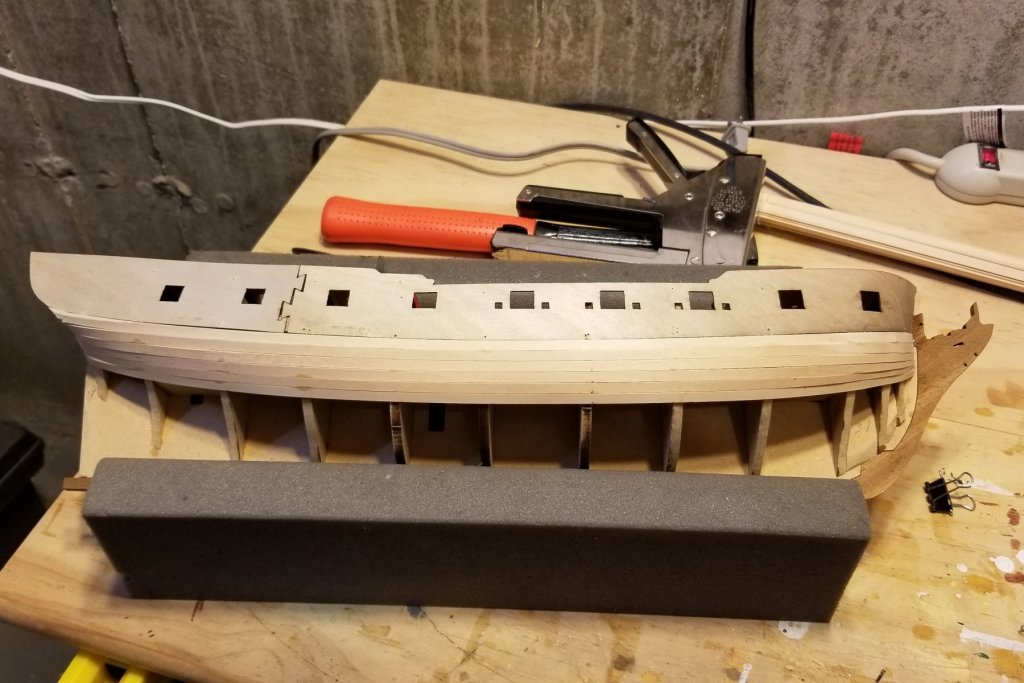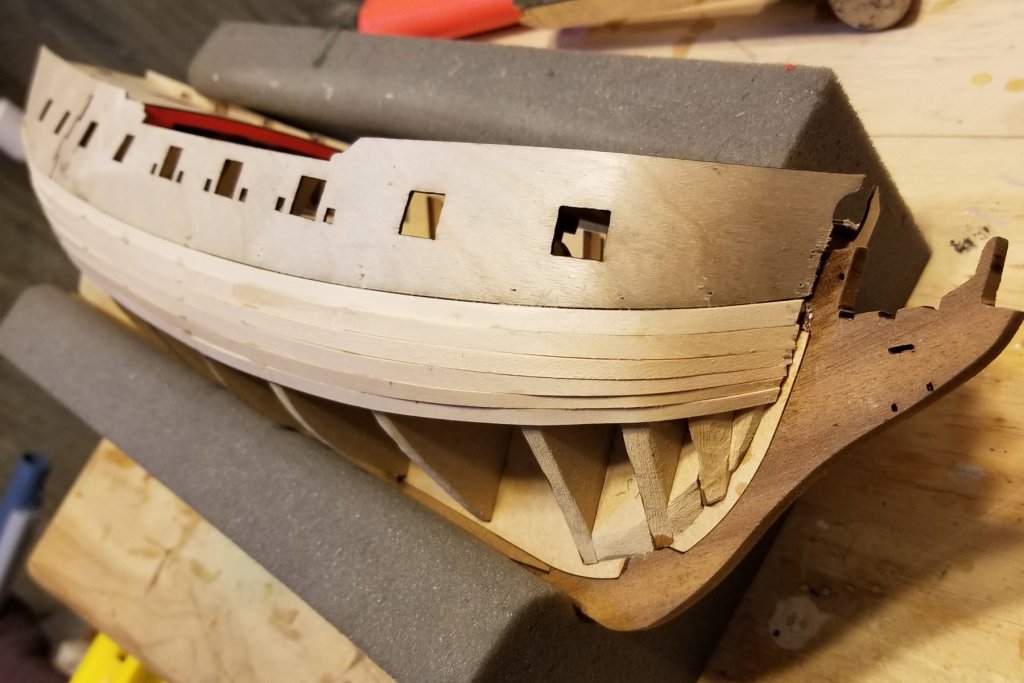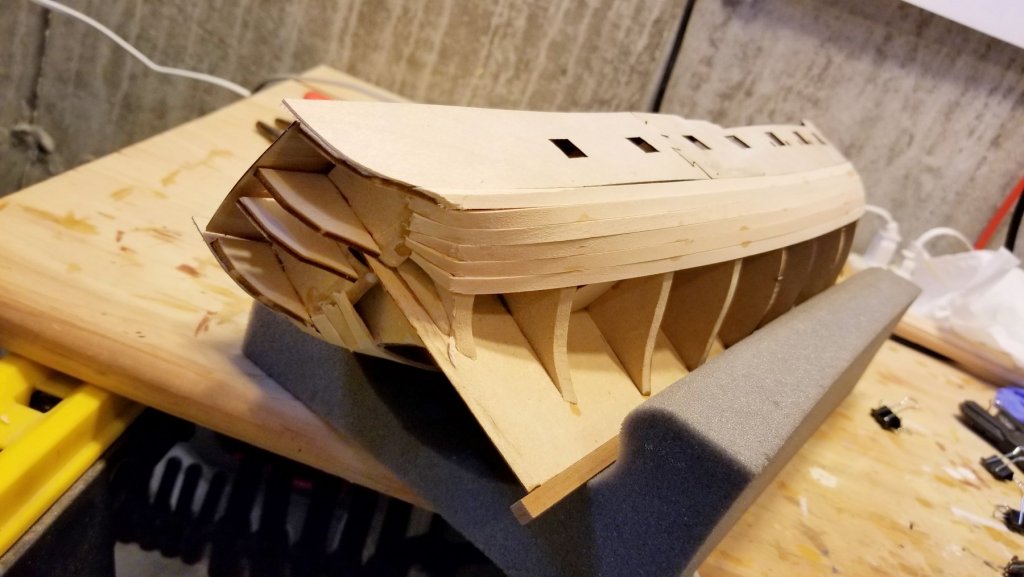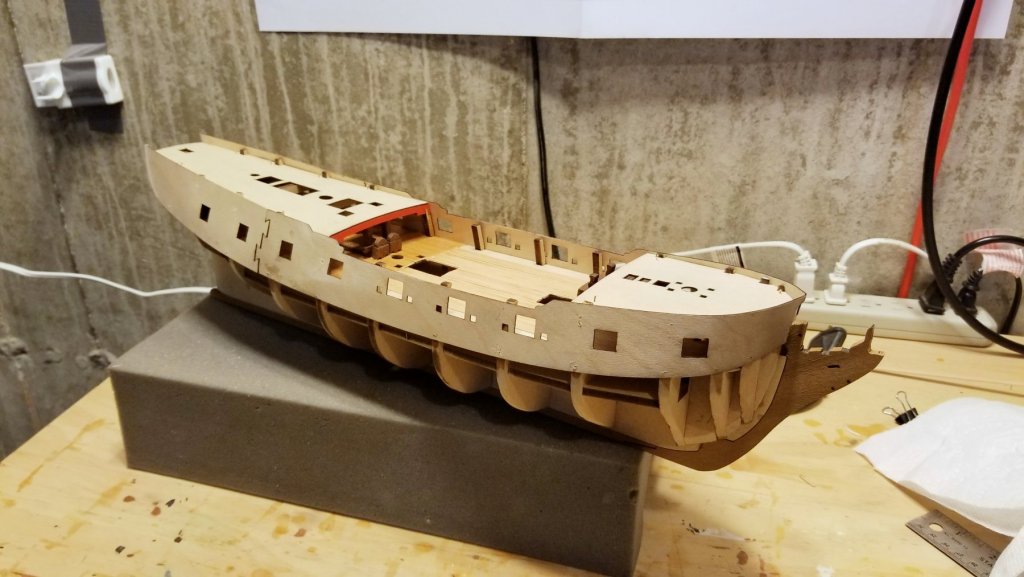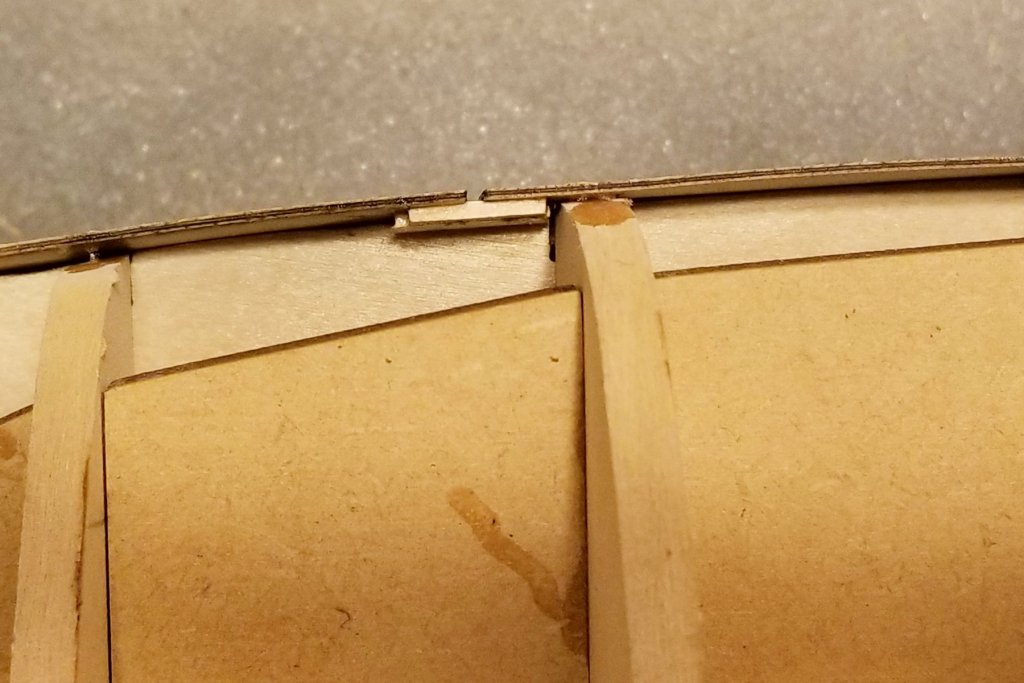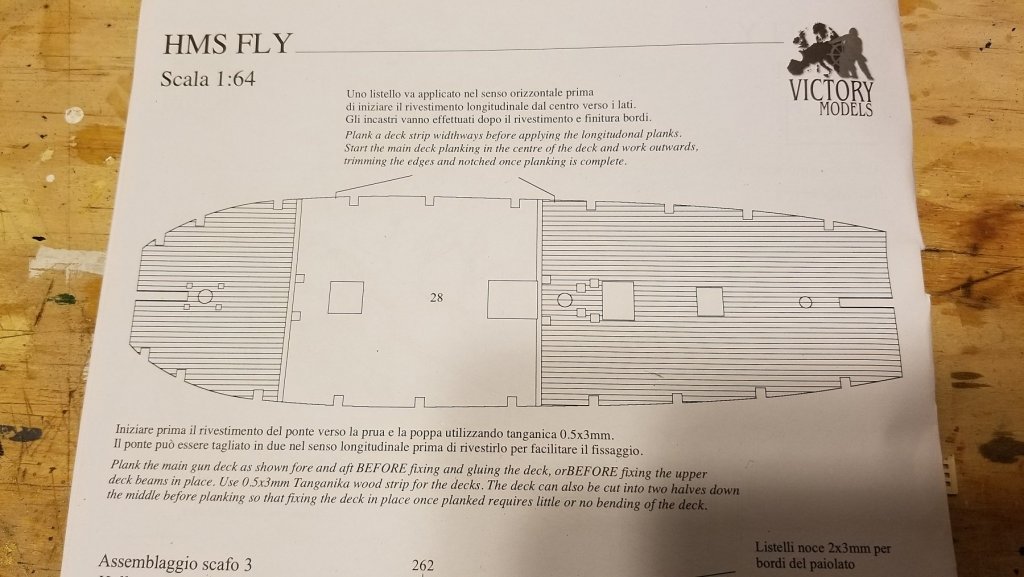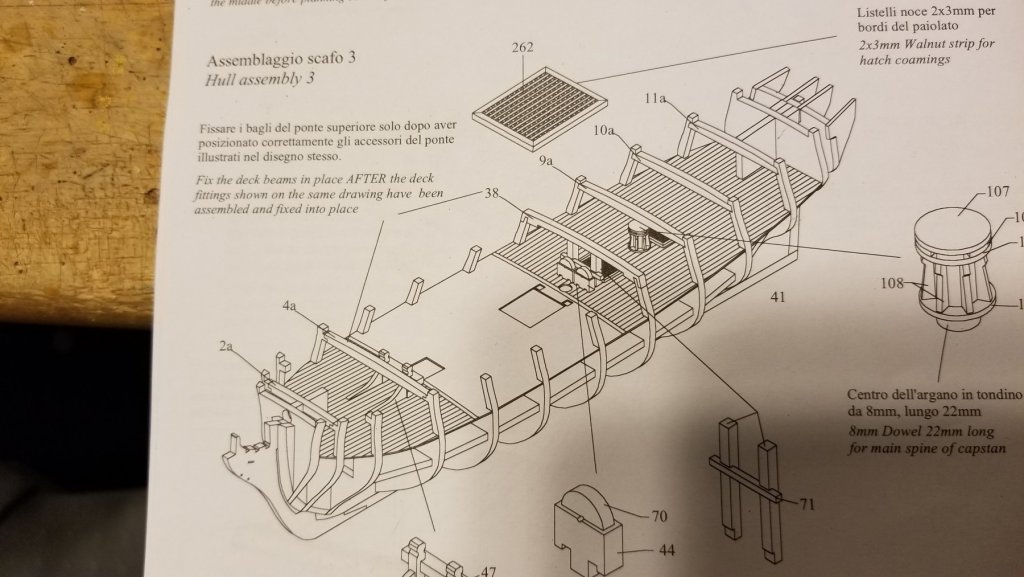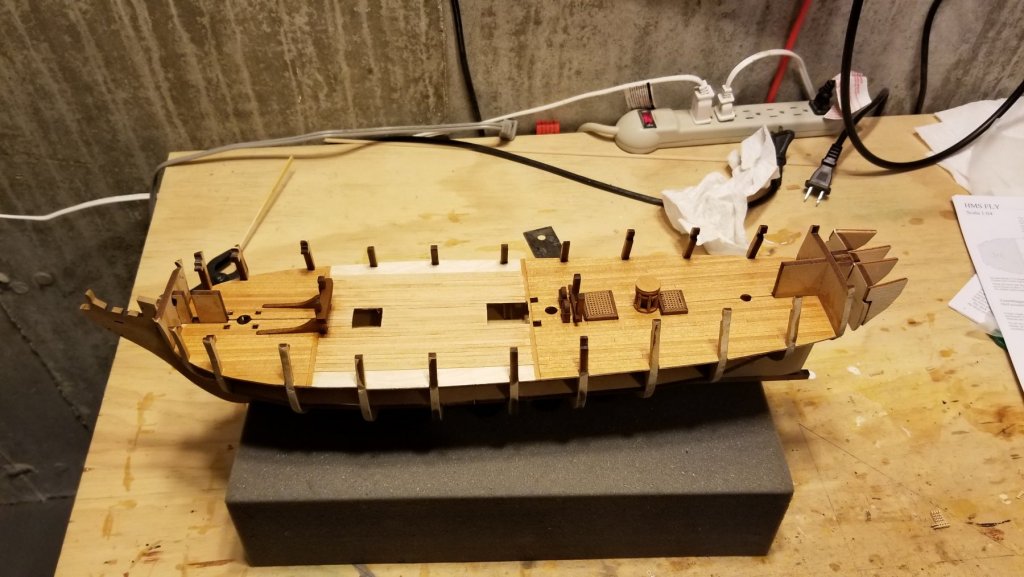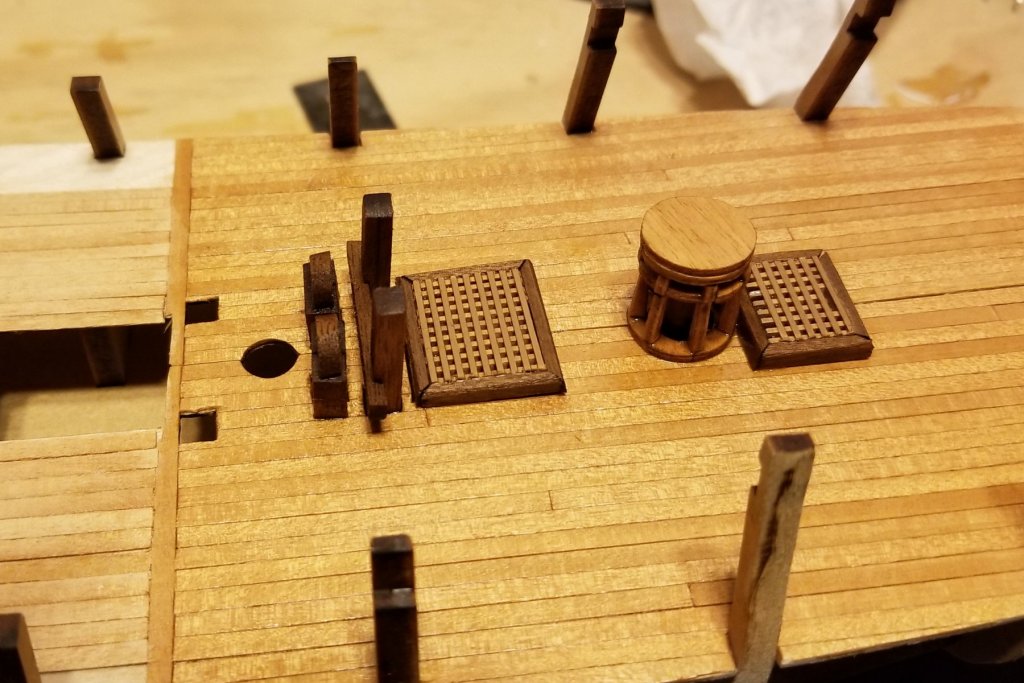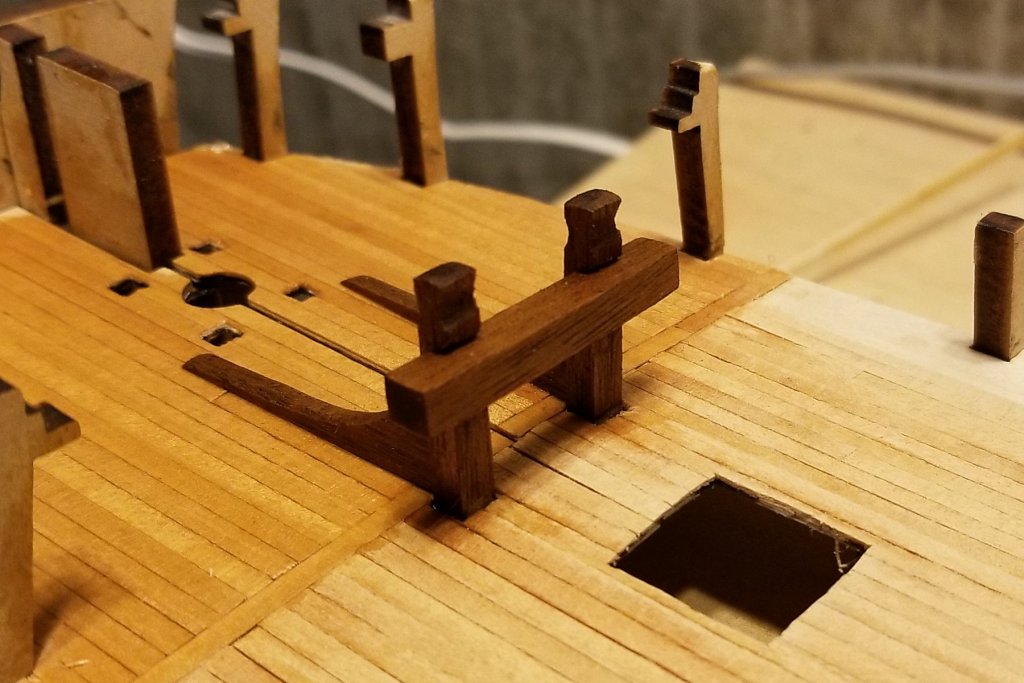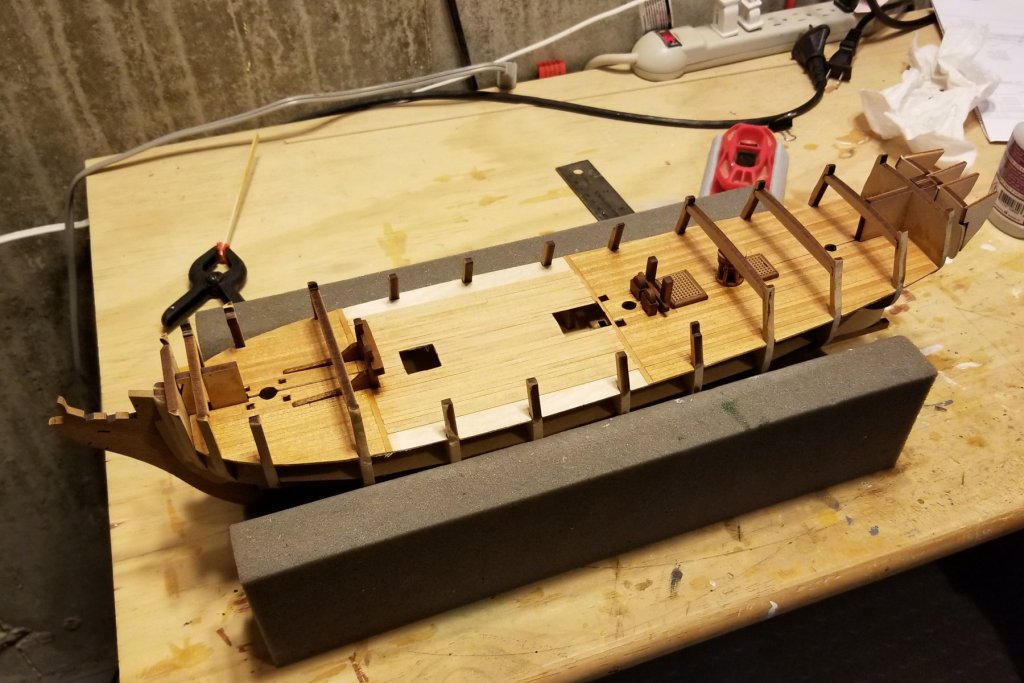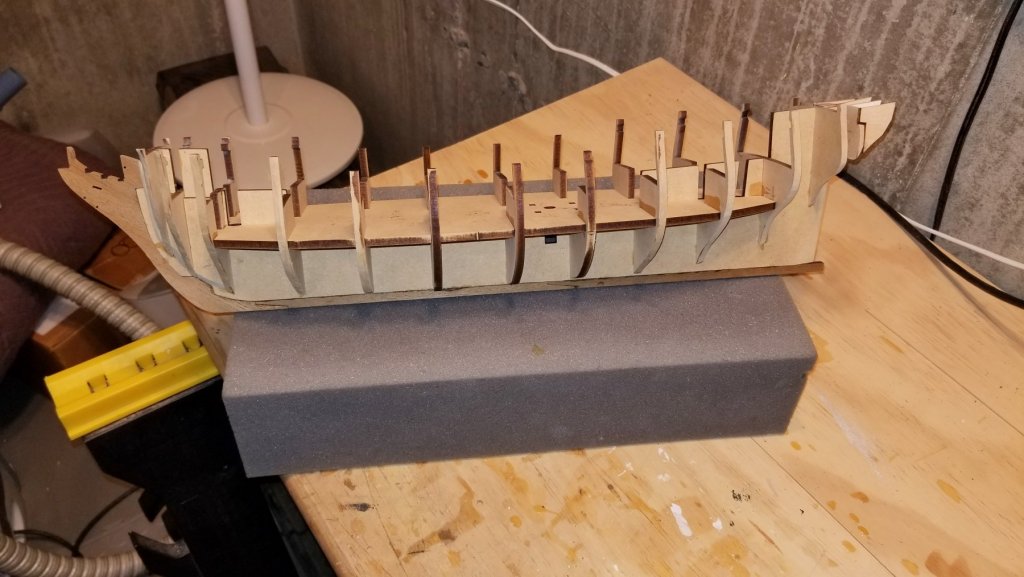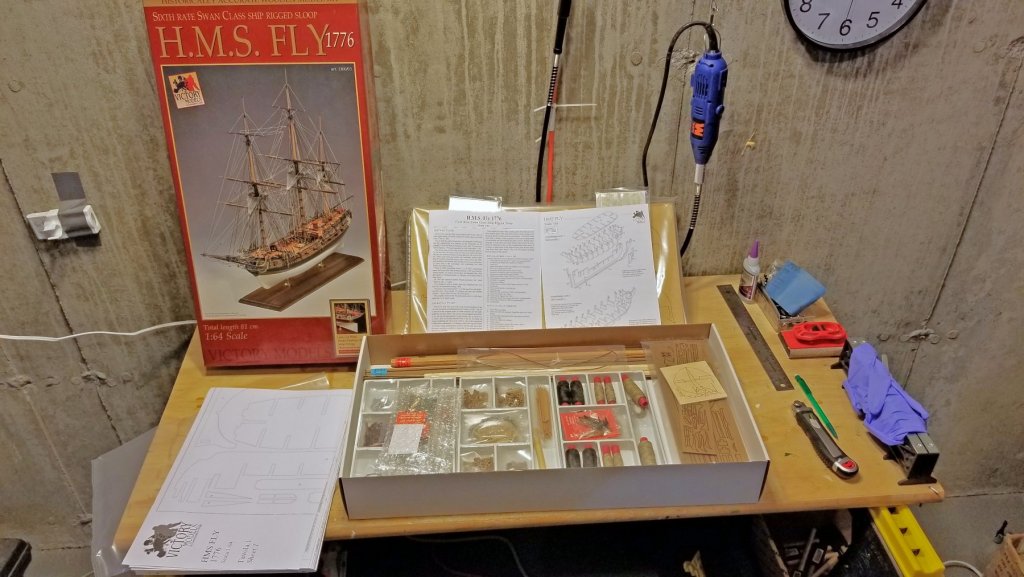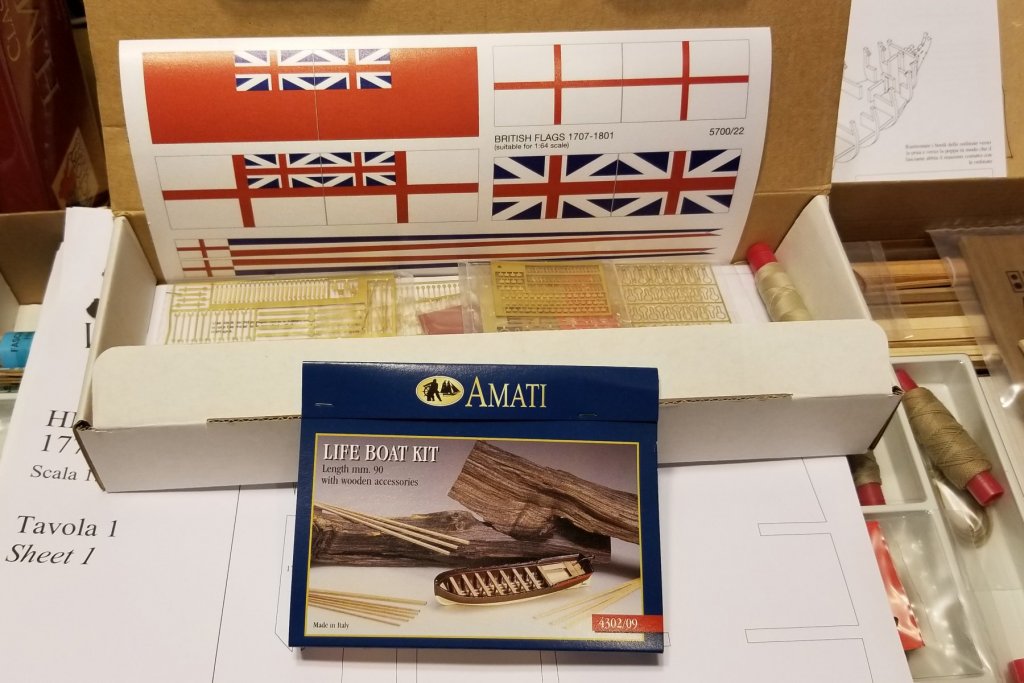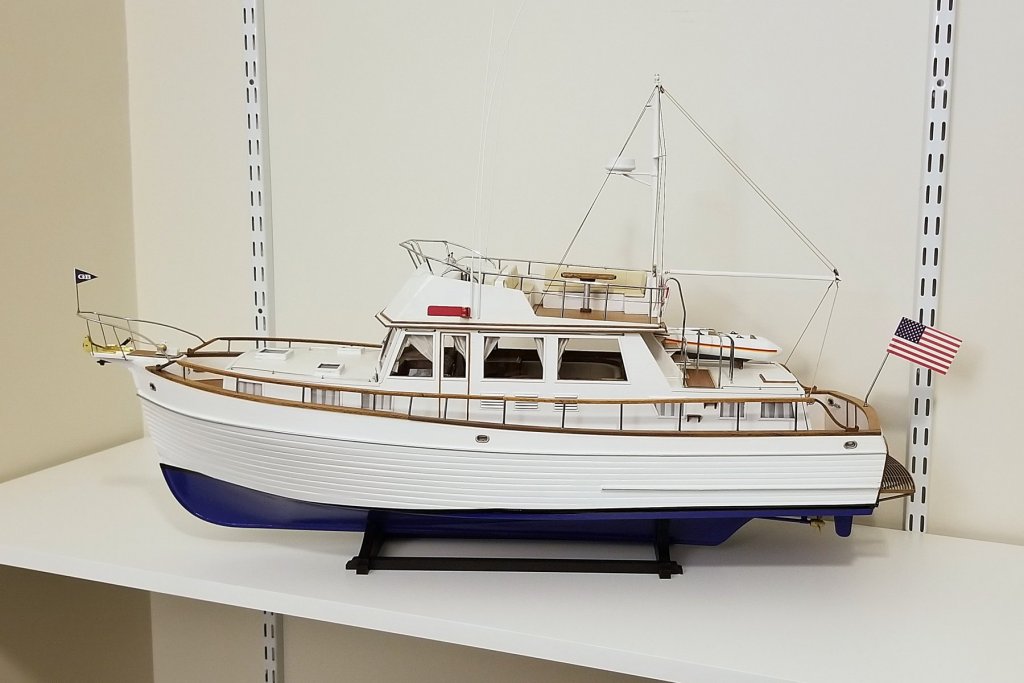-
Posts
1,071 -
Joined
-
Last visited
Content Type
Profiles
Forums
Gallery
Events
Everything posted by drobinson02199
-
Wood filler and sanding applied to first planking, plus a coat of varnish. Now ready for second planking. Regards, David
- 126 replies
-
- fly
- victory models
-
(and 1 more)
Tagged with:
-
First planking done with one rough sanding pass. Now wood filler and sand, sand, sand. Regards, David
- 126 replies
-
- fly
- victory models
-
(and 1 more)
Tagged with:
-
Antony: Just found this fabulous build, and I'm on board to watch the rest of the way. Your prowess (and ambition) with scratch builds is terrific. Regards, David
-
I want to thank Blue Ensign for his really great advice -- and for stating it strongly so that I'd have the motivation to rip out planks and go back. So I did just what B.E. recommended above. You can see the removal and the re-do in the pics below. Much, much better plank line, and I can see how the former one would have not just "led to problems down the line", but actually have been a disaster. I have to confess that I found the drawings not very helpful in understanding how the stern should look, and I was also led astray by the initial size of the second bulkhead. I assumed (wrongly) that it would have been made closer to its target size. What helped a lot was scouring all of the build logs on Fly, which helped me understand how the lower stern counter mates with the planking. The drawings were just a mystery to me. Again, thanks and kudos to Blue Ensign. Regards, David
- 126 replies
-
- fly
- victory models
-
(and 1 more)
Tagged with:
-
Mike: Thank you so much for the substantial time you put into that post. I have been tapering the planks at the bow, but I may start further back as you suggest. Your stern bend on the Pegasus looks shallower than mine on the Fly. That's either because the ships are different in that regard, or maybe I should have beveled that last bulkhead more to create a shallower drop -- but it's too late now. I see what you mean about the stealers. I have looked at the other Fly logs and can't get a good handle on whether their bend is as steep as mine. I haven't worried a lot about the side effect of pulling the stern planks over to align them, again because sanding and wood filler are my best friends on layer 1. Not so with the second planking. When I built the Revenge, I edge bent the second planks using clamps, a steamer and a hair dryer. It takes a long time, but they really lay well when I get it right. Lots of snake-like S-bent planks! Also lots of stealers where needed. Regards, David
- 126 replies
-
- fly
- victory models
-
(and 1 more)
Tagged with:
-
Mike: Thanks for all of this. Sanding and filler is in fact my very best friend -- I just think that I may for a change end up with more planks than filler on the first planking. You should see my earlier attempts -- tubs of filler You are right about the clinking, but these first planks are 1.5mm so plenty of room for sanding. On the stern: the sharp bend is there whether I try to align with the plank above or not. I have a really good steamer, and the cracks you see are partly a function of me being too impatient and not steaming enough. When I do steam enough, I can really move the planks where I want them. I have studied pictures and build logs to be sure I understand the run of planks at the stern -- and I think I do, although the plans are not terribly helpful on that score. From what I can figure out, that sharp bend is part of the deal on this boat. The stealer count will go up with the second planking. You said "from what I can recall." Have you built the Fly? I only see the Pegasus in your signature. If you have built the Fly, or if the Pegasus is similar, how did you handle the bend at the stern? (just the bend -- not the alignment part). Regards, David
- 126 replies
-
- fly
- victory models
-
(and 1 more)
Tagged with:
-
First planking underway. This is the smoothest and best-fitting first planking I've done to date, and I think the reason is that I beveled each bulkhead separately off the ship before installing it and gluing it it, testing each one with a test plank for fit. So far, things are lying nicely. Regards, David
- 126 replies
-
- fly
- victory models
-
(and 1 more)
Tagged with:
-
Bulwarks on and ready for first planking. The bottom edge of the rear bulkhead was springing out where it joins the front bulkhead, so I added a small stiffener behind it. Second picture. Mindful of advice above from Mike and Chris, I considered gluing down the top decks at this point (the instructions say to do it after both plankings). I finally decided to wait, on the off chance that while manipulating the hull so much during planking, I'd knock one of the cannon carriages loose. Speaking of the cannon carriages: the original ones are metal with some interesting detail, while the ones supplied in the upgrade kit are wood with smooth sides. I think that's because the wood allows for the fancier cannon rigging as eyes can be installed in the carriages, but I like the look of the metal ones, so I'll use those and the simpler rigging. Regards, David
- 126 replies
-
- fly
- victory models
-
(and 1 more)
Tagged with:
-
Chris Coyle: Yes, I can see from some of the build logs on Fly that others have just done one continuous planking run, but they are on there now with fittings glued on top, so on they stay. Chris Vossy: Speaking of materials, my Fly kit only has "natural" thread at the thickness needed for ratlines. I looked at all of the Fly pics I could find, and all show black thread, so I think I'm expected to dye the natural thread black. No way -- I bought some black thread for the ratlines. I also agree with you about things not being mentioned or being assumed -- these instructions are a bit sketchy compared to the Revenge ones, which were magnificent. Both Chris Watton -- just different time periods. Regards, David
- 126 replies
-
- fly
- victory models
-
(and 1 more)
Tagged with:
-
This last stage I've finished wasn't helped by the instructions. Look at the two drawings below. The first one shows how the gun deck should be initially planked, and I placed those lateral planks where indicated. Now look below, and you'll see that they have moved. The issue is that one of the deck fittings straddles the planks I installed and the center section, so as a fix I had to go ahead and plank the center portion out to just before the "tear off" bulkheads, so that I could fit that forward part across planked deck. You can see it in the pictures that follow -- I haven't varnished the center section yet and won't until I finish planking it out to the bulkheads. At the end of the day, I'm fine with how this turned out, but it's an interesting inconsistency on the same page of the instructions. The final picture shows the deck beams installed. The deck fittings I left natural -- partly because I love the look of varnished walnut, and partly because I don't want to overload the look of the boat with red fittings. The capstan you see won't be visible. I'll paint the other one on the deck above it red. You can see one of the fittings straddling old and new planking because of the way the lateral planks were drawn on the large deck diagram as noted above. The instructions also say to cut the deck in half before planking and installing -- but mine came with the deck laser cut in two halves already. I planked them before installing. The kit must have been updated. At the end of the day, I'm sort of glad that I ran into this issue, because if I had waited to plank the center section to the point called for in the instructions, I'd be working around the installed deck support beams, and that would be much more difficult. I ordered some red paint on express delivery, because the red I have is too "cherry", and that is supposed to be delivered tomorrow, which is good, because I need to start painting some things red to keep going. Regards, David
- 126 replies
-
- fly
- victory models
-
(and 1 more)
Tagged with:
-
Thanks, Doc. That's a great link and very helpful to know about it. Regards, David
- 126 replies
-
- fly
- victory models
-
(and 1 more)
Tagged with:
-
Chris: I never know -- but a series of winter vacations has now come to an end, so I have more time to work on the model. I can't tell yet how complex this one will be. I know that it has fewer decks than the Revenge did. I expect to hit hull planking within a few days. Regards, David
- 126 replies
-
- fly
- victory models
-
(and 1 more)
Tagged with:
-
Don: Those hull blocks are incredibly cool! Regards, David
- 223 replies
-
The keel and frames are done as shown below. I thought the instruction in the manual to bevel the frames before installation was great, so dry fitted the whole assembly and used a strip of first planking wood to eyeball the curves. Then I glued in the middle three frames and popped in the deck for alignment. I use CA, so dry in no time and perfectly aligned. Then popped out the deck and beveled the next two frames on either side, testing with the strip as I went along, then gluing in those frames, and so forth. The result is that most of the sanding is out of the way, and these frames are a lot better beveled for planking than in my other efforts where I did all the sanding after gluing everything. The manual says that the Fly is designed for a novice-intermediate builder. Intermediate maybe, but I think a novice would have trouble given the lack of detailed pictures with the instructions. Regards, David
- 126 replies
-
- fly
- victory models
-
(and 1 more)
Tagged with:
-
Brian: Thanks -- I have been through your log front to back. Very helpful. Second planking is "the gift that keeps on giving" Regards, David
- 126 replies
-
- fly
- victory models
-
(and 1 more)
Tagged with:
-
So I'm back from a couple of weeks in the sun, and ready to tackle a new project after my great experience with the Amati Heritage 46. There have been a number of really great logs done on this ship, which are a great reference. What I can perhaps add to the party is some comments as I go on differences I encounter with this kit vs. my experience with the Revenge, which is the newest ship in the Amati Victory Models line -- the H.M.S. Fly is an earlier kit. I'll begin with the obligatory "what's in the box" pictures. In addition to the usual wood and laser cut and other parts, there is an instruction book, assembly pictures, and a set of large plans. What I notice right away is that the instruction book is not as richly illustrated (and may not be as detailed) as the one that came with the Revenge was. By the way, if you are looking very closely at the first pic, you might see a brass pedestal package. Those did NOT come with the ship -- I ordered them separately and just put them in the kit box to avoid losing them. I also had to order a base separately. The first pic is the upgrade kit, which contains more brass fittings, some flags, a lifeboat kit, and who knows what else. We'll see. Time to dig in. Regards, David
- 126 replies
-
- fly
- victory models
-
(and 1 more)
Tagged with:
About us
Modelshipworld - Advancing Ship Modeling through Research
SSL Secured
Your security is important for us so this Website is SSL-Secured
NRG Mailing Address
Nautical Research Guild
237 South Lincoln Street
Westmont IL, 60559-1917
Model Ship World ® and the MSW logo are Registered Trademarks, and belong to the Nautical Research Guild (United States Patent and Trademark Office: No. 6,929,264 & No. 6,929,274, registered Dec. 20, 2022)
Helpful Links
About the NRG
If you enjoy building ship models that are historically accurate as well as beautiful, then The Nautical Research Guild (NRG) is just right for you.
The Guild is a non-profit educational organization whose mission is to “Advance Ship Modeling Through Research”. We provide support to our members in their efforts to raise the quality of their model ships.
The Nautical Research Guild has published our world-renowned quarterly magazine, The Nautical Research Journal, since 1955. The pages of the Journal are full of articles by accomplished ship modelers who show you how they create those exquisite details on their models, and by maritime historians who show you the correct details to build. The Journal is available in both print and digital editions. Go to the NRG web site (www.thenrg.org) to download a complimentary digital copy of the Journal. The NRG also publishes plan sets, books and compilations of back issues of the Journal and the former Ships in Scale and Model Ship Builder magazines.



